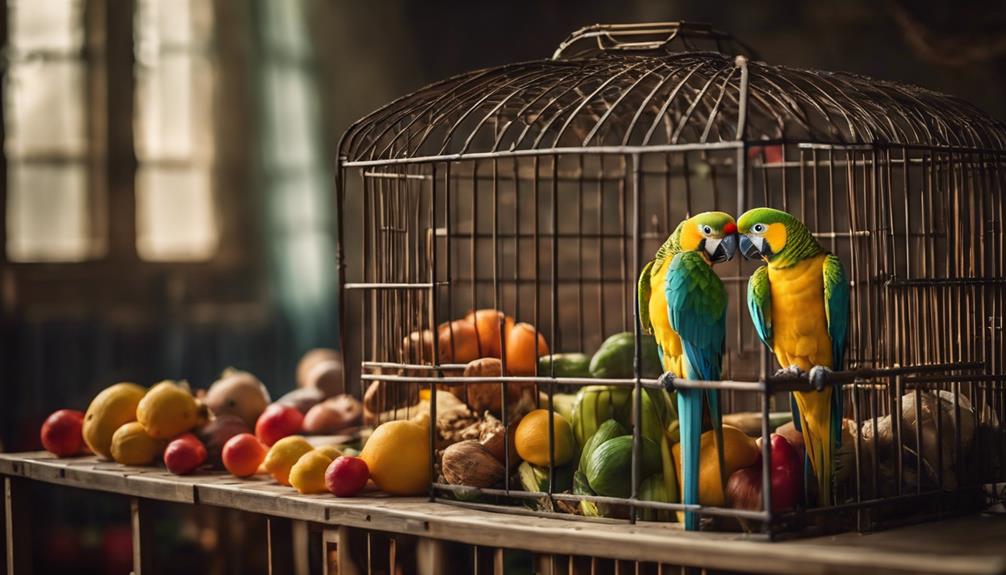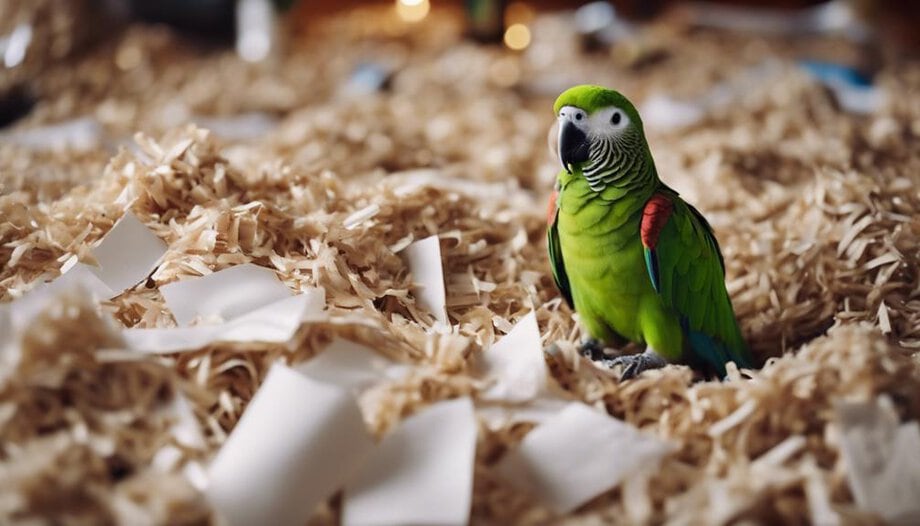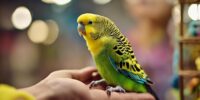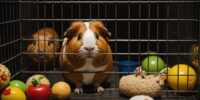What Habitat Requirements Are Essential for Quaker Parrots?

Quaker parrots, also known as monk parakeets, have specific habitat requirements that need to be met in order for them to thrive in captivity. These requirements include a spacious cage that allows for ample room to move around and stretch their wings. Quaker parrots are highly active birds that need plenty of mental stimulation, so it is important to provide them with a variety of toys and perches to keep them entertained. Additionally, quaker parrots are social creatures that thrive on interaction, so it is recommended to spend time with them daily to build a bond and provide companionship.
Creating a safe and comfortable environment for your quaker parrot is essential for their overall well-being. Make sure to place their cage in an area with plenty of natural light, but away from drafts and direct sunlight. Provide them with a balanced diet of high-quality pellets, fresh fruits, and vegetables, as well as clean water at all times. Regularly clean their cage and toys to prevent the buildup of bacteria and mold, which can be harmful to your bird's health. By meeting these essential habitat requirements, you can ensure that your quaker parrot lives a happy and healthy life in captivity.
Key Takeaways
- Quaker parrots need a cage minimum of 60cm in length, width, and height for space and activity.
- Provide natural wood perches of varying diameters at different heights for foot exercise.
- Offer a variety of toys with different textures and shapes for mental stimulation and physical activity.
- Maintain proper hygiene with clean bedding, suitable substrates, and optimal temperature and humidity levels.
Ideal Cage Size
An optimal cage size for Quaker Parrots is crucial to ensure their physical and mental well-being, with dimensions no less than 60cm in length, width, and height. Quaker Parrots are active and intelligent birds that require ample space to move around. A cage of suitable size allows for the inclusion of various perches, toys, and swings, providing opportunities for exercise and mental stimulation. The presence of horizontal bars in the cage is essential as it enables the parrots to climb and exercise their feet, mimicking their natural behaviors in the wild.
Placing the cage in a well-lit area but away from direct sunlight and drafts is vital for the well-being of Quaker Parrots. Adequate lighting helps regulate their circadian rhythms and ensures they receive the necessary exposure to natural light. By incorporating different elements like perches, toys, and swings into the cage setup, owners can prevent boredom and engage their feathered companions in enriching activities that promote overall health and happiness.
Proper Perches

Quaker parrots require perches made of natural wood to maintain their beak health and provide a comfortable surface for perching.
The perches should vary in diameter to exercise the birds' feet and prevent foot problems.
Placing perches at different heights within the habitat encourages movement and mental stimulation for the parrots.
Ideal Perch Materials
Using a variety of natural, untreated wood perches is essential for maintaining the foot health and overall well-being of Quaker parrots. These perches should vary in diameter to exercise foot muscles and prevent arthritis. Avoid sandpaper perches as they can cause abrasions. Providing different textures like rope perches can keep the bird's feet healthy and stimulated. Placing perches at varying heights within the cage encourages natural movement and exercise.
- Choose natural, untreated wood perches.
- Ensure perches vary in diameter.
- Avoid sandpaper perches.
- Provide different textures like rope perches.
Perch Size Considerations
Selecting appropriate perch sizes is crucial for maintaining the foot health and overall well-being of Quaker parrots in captivity. Quaker parrots require perches of varying diameters to exercise their feet and prevent foot problems.
It's essential to provide perches made of safe, natural wood like manzanita or dragonwood to support foot health. To promote foot dexterity and prevent muscle atrophy, include at least 3-4 perches with different thicknesses in the cage.
Placing perches at various heights within the enclosure encourages movement and exercise, contributing to the birds' overall well-being. Regularly inspect the perches for wear and tear, replacing them promptly if any damage is observed to avoid potential injuries to the Quaker parrots.
Variety of Toys

Providing a diverse array of toys is essential for maintaining the mental well-being and preventing boredom in Quaker parrots. These intelligent birds require mental stimulation to thrive in captivity. To ensure their overall well-being, it's crucial to offer a variety of toys that cater to their natural instincts and curiosity.
Here are some key considerations when selecting toys for Quaker parrots:
- Different Textures, Colors, and Shapes: Toys with a mix of textures like wood, ropes, and plastic, along with vibrant colors and various shapes, can captivate a Quaker parrot's interest and prevent monotony.
- Rotate Toys Regularly: Changing the toys in the bird's environment frequently helps maintain their engagement levels and prevents them from getting bored with their surroundings.
- Puzzle Feeders: Toys that double as puzzle feeders not only provide mental stimulation but also encourage foraging behavior, keeping the bird active and occupied.
- Interactive Toys: Items such as bells, ropes, and interactive toys that promote physical activity, problem-solving, and playtime contribute significantly to the mental and physical well-being of Quaker parrots.
Suitable Bedding Material

To ensure the comfort and health of Quaker parrots, it is imperative to provide appropriate bedding material in their cages, such as clean, dust-free paper towels or newspaper. Avoid harmful materials like cedar or pine shavings that can negatively impact their respiratory system. Bedding should be changed regularly to maintain cleanliness, prevent bacterial growth, and ensure a healthy environment for your Quaker parrot. It is essential to provide enough bedding to cushion the cage floor but avoid excessive amounts that may impede your bird's movement. Regularly monitor the bedding for signs of mold, dampness, or soiling to promptly address any issues and maintain a hygienic environment. By following these guidelines, you can create a safe and comfortable space within your Quaker parrot's cage.
| Clean Bedding Material | Change Regularly | Monitor for Signs of Mold |
|---|---|---|
| Paper towels or newspaper | Maintain cleanliness | Check for dampness or soiling |
Adequate Lighting

Quaker parrots rely on exposure to natural sunlight or UVB lighting for a minimum of 10-12 hours daily to maintain optimal health. Adequate lighting is crucial for these birds, impacting various aspects of their well-being.
Here are some key points to consider:
- Vitamin D3 Absorption: Adequate lighting is essential for Quaker parrots to synthesize Vitamin D3, which plays a vital role in calcium metabolism and overall health.
- Preventing Deficiencies: Natural sunlight exposure helps prevent Vitamin D deficiency, reducing the risk of health issues such as weak bones or egg-binding in female Quaker parrots.
- Full-Spectrum Lighting: Providing full-spectrum lighting, which mimics natural sunlight, through specialized bulbs or fixtures ensures that Quaker parrots receive the appropriate lighting for their needs.
- Health Implications: Insufficient lighting can lead to metabolic bone disease and poor feather quality in Quaker parrots, emphasizing the significance of proper lighting in their habitat.
Temperature and Humidity Control

Quaker parrots require a temperature range between 65-85°F to maintain optimal health and well-being.
Humidity levels should fall within the 40-70% range to prevent respiratory issues and mimic their natural environment.
Monitoring tools such as thermometers and hygrometers are essential for accurately gauging these critical factors in the parrot's habitat.
Optimal Temperature Range
Maintaining a temperature range between 65-85°F (18-29°C) and humidity levels around 40-70% is essential for ensuring the optimal habitat conditions for Quaker parrots. Sudden temperature fluctuations must be avoided to prevent stress and health issues in these birds.
Proper ventilation plays a crucial role in maintaining optimal air quality and preventing respiratory problems. Excessive humidity above 70% can lead to mold growth and respiratory issues in Quaker parrots.
Monitoring the temperature and humidity using a reliable hygrometer and thermometer is vital for creating and sustaining a healthy environment for these birds. Providing the right temperature and humidity levels is key to promoting the well-being and longevity of Quaker parrots in captivity.
Humidity Level Requirements
To ensure optimal habitat conditions for Quaker parrots, it's crucial to closely monitor and control both temperature and humidity levels within the recommended ranges. Quaker parrots thrive in temperatures ranging from 65-85°F (18-29°C) with humidity levels maintained around 40-70%.
Deviations from these ranges can result in health problems such as dry skin and respiratory issues in low humidity conditions, while high humidity levels above 70% can foster mold growth, posing risks to the birds' well-being. Consistency in temperature and humidity is key to preventing stress and health issues.
Employing tools like a digital thermometer and humidity gauge can help maintain an optimal environment, supporting the respiratory health and overall wellness of Quaker parrots.
Safe and Secure Environment

An adequate safe and secure environment for Quaker parrots necessitates a spacious cage with specific dimensions to facilitate their natural behaviors and well-being.
- Minimum Cage Size: A cage of at least 60cm long, 60cm wide, and 60cm high provides ample room for movement and comfort.
- Horizontal Bars and Perches: Horizontal bars allow for climbing, while multiple perches encourage perching and climbing activities, mimicking their natural habitat.
- Well-Lit Location: Placing the cage in a well-lit area away from drafts and direct sunlight ensures a comfortable and safe environment for the pet Quaker parrot.
- Toys, Swings, and Hygienic Living Space: Including toys and swings inside the cage promotes mental stimulation and physical exercise, preventing boredom. Additionally, using a tray or grate at the bottom of the cage facilitates easy cleaning, maintaining a hygienic living space for the Quaker parrot.
Frequently Asked Questions
What Is the Habitat of the Quaker Parrot?
Quaker parrots prefer habitats with access to flowers, bark, seeds, and insects for natural foraging. They are adaptable to urban environments, nesting in trees, cliffs, and man-made structures. Their intricate nests can expand over 1 meter in diameter.
What Are the Cage Requirements for a Quaker Parrot?
Quaker parrots require a cage that's at least 60cm in length, width, and height. Providing various perches, toys, and swings encourages natural behavior. Placing the cage in a well-lit area, away from drafts, is crucial for their well-being.
What Do Quaker Parrots Need?
Quaker parrots need a variety of food preferences, social interactions, exercise needs, vocalizations, and enrichment activities to stay healthy and happy. They require a balanced diet, interaction, playtime, and behavioral training for optimal well-being.
What Is the Habitat of a Parrot?
A parrot's habitat typically includes a tropical climate with abundant tree branches, natural vegetation, open spaces, nesting sites, and access to water. They thrive in environments that support flock behavior, social interactions, flight opportunities, and diverse food sources.











